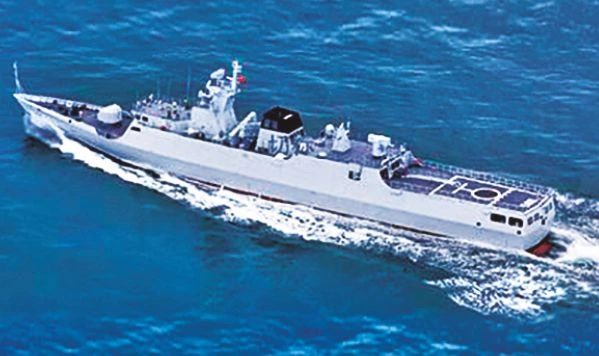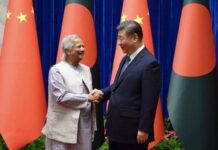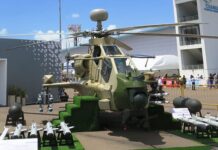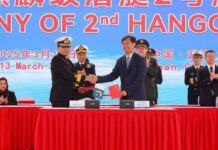Key Takeaways
• The PLAN is numerically the largest navy in the world with an overall battle force of approximately 340 ships and submarines, including approximately 125 major surface combatants. As of 2021, the PLAN is largely composed of modern multi-mission ships and submarines.
• In 2021, the PLAN’s overall battle force shrank due to the transfer of 22 early flight JIANGDAO class corvettes to the China Coast Guard.
• The PLAN commissioned its fourth RENHAI class cruiser (CG) in late 2021 and resumed series construction of the JIANGKAI II class frigate.
• The PLAN commissioned two YUSHEN class amphibious assault ships, one each in April 2021 and April 2022. The PLAN launched a third hull in the class in January 2021, which is currently undergoing sea trials prior to commissioning.
Recent Developments
In the near-term, the PLAN will have the ability to conduct long-range precision strikes against land targets from its submarine and surface combatants using land- attack cruise missiles, notably enhancing the PRC’s power projection capability.
The PRC’s 2019 defense white paper described the People’s Liberation Army Navy (PLAN) as adjusting to changes in the strategic requirements of near seas protection and far seas protection, noting that it was “speeding up the transition of its tasks from defense on the near seas to protection missions on the far seas.” The PLAN is an increasingly modern and flexible force that has focused on replacing its previous generations of platforms that had limited capabilities in favor of larger, modern multi-role combatants. As of 2021, the PLAN is largely composed of modern multi-role platforms featuring advanced anti-ship, anti-air, and anti- submarine weapons and sensors. The PLAN is also emphasizing maritime joint operations and joint integration within the PLA. This modernization aligns with the PRC’s growing emphasis on the maritime domain and increasing demands for the PLAN to operate at greater distances from mainland China.
The PLAN organizes, mans, trains, and equips the PLA’s naval and naval aviation forces, as well as the PLAN Marine Corps (PLANMC), which is subordinate to the PLAN. The PLAN continues to implement structural reforms that began in late 2015 and early 2016. Similar to the other services, the PLA-wide reforms removed the PLAN headquarters from conducting operations, which became the purview of the PLA’s joint Theater Commands, and focused the PLAN on organizing, manning, training, and equipping naval forces.
Missions. The PLAN continues to develop into a force increasingly capable of global operations, gradually extending its operational reach beyond East Asia. The PLAN’s latest surface and subsurface platforms enable combat operations beyond the reach of the PRC’s land-based defenses. In particular, China’s growing force of aircraft carriers extend air defense coverage of deployed task groups beyond the range of land based defenses and will enable operations at increasingly longer ranges. The PLAN’s emerging requirement for sea- based land-attack systems will also enhance the PRC’s ability to project power. Furthermore, the PLAN now has a sizable force of highly capable logistical replenishment ships to support long-distance, long-duration deployments, including two new FUYU class fast combat support ships (AOEs) built specifically to support aircraft carrier operations. The PLAN’s expanding fleet of large modern amphibious warships will enable it to conduct a wide range of expeditionary operations wherever PRC interests are threatened or in support of PRC participation in internationally sanctioned operations. The expansion of naval operations beyond China’s immediate region will also facilitate its non-war military activities and further legitimize the PRC’s growing global military posture, including at its base in Djibouti.
China continues to learn lessons from operating its first aircraft carrier, Liaoning. Its first domestically built aircraft carrier, Shandong, was launched in 2017 and commissioned in December 2019-the beginning of what the PLA states will be a multi-carrier force. China’s next generation of carriers, including one that began construction in 2018, will have greater endurance and an electromagnetic catapult launch system making it capable of launching various types of specialized fixed-wing aircraft for missions such as early warning, electronic warfare (EW), and anti-submarine warfare (ASW). This will increase the striking power of a potential PLAN carrier battle group when deployed to areas beyond China’s immediate periphery. China’s newest aircraft carrier, the Fujian, is expected commission in 2024.
The PLAN’s newest amphibious ships, the YUSHEN class Landing Helicopter Assault (LHA) and YUZHAO class Amphibious Transport Docks (LPD) are modern platforms capable of regional and global expeditionary missions in support of both wartime and non-war contingency operations either singly or as part of capable and flexible task groups composed of multiple amphibious ships and surface combatants.
The PLAN’s ability to perform missions beyond the First Island Chain is modest but growing as it gains more experience operating in distant waters and acquires larger and more advanced platforms. China’s experience in extended range operations primarily comes from extended task group deployments and its ongoing counterpiracy mission in the Gulf of Aden. Notable deployments in 2021 included the following:
• In April 2021 and December 2021, the PRC aircraft carrier Liaoning conducted deployments to the Philippine Sea and South China Sea accompanied by escort ships including the RENHAI class cruiser Nanchang during both deployments. According to the Japanese Self-Defense Force, the December deployment included night flight operations almost 200 miles southeast of Okinawa with the task group accompanied by a FUYU class AOE.
• In May of 2021, a PLAN task group operated in the South China Sea, Java Sea, and Celebes Sea, and conducted an exercise with the Indonesian Navy.
• In August and September 2021, a PLAN task group that included a RENHAI class cruiser and an AGI deployed to the North Pacific and operated inside the U.S. EEZ in Alaskan waters.
• In October 2021, PLAN and Russian warships exercised in the Sea of Japan and then sailed into the Pacific Ocean through the Tsugaru Strait that separates the Japanese Islands of Honshu and Hokkaido.
• The PLAN sustained its counter-piracy task groups in the Gulf of Aden through 2021, a 13-year effort that is the PRC’s first enduring naval operation beyond the Indo- Pacific region.
Force Structure. The PLAN is the largest navy in the world with a battle force of approximately 340 platforms, including major surface combatants, submarines, ocean-going amphibious ships, mine warfare ships, aircraft carriers, and fleet auxiliaries. In 2021, the PLAN’s overall battle force shrank due to the transfer of 22 early flight JIANGDAO class corvettes to the China Coast Guard. This figure does not include approximately 85 patrol combatants and craft that carry anti-ship cruise missiles (ASCM). The PLAN’s overall battle force is expected to grow to 400 ships by 2025 and 440 ships by 2030. Much of this growth will be in major surface combatants. The PLAN’s force structure consists of three fleets with subordinate submarine flotillas, surface ship flotillas, aviation brigades, and naval bases. The PLAN’s Northern Theater Navy is subordinate to the Northern Theater Command, the Eastern Theater Navy is subordinate to the Eastern Theater Command, and the Southern Theater Navy is subordinate to the Southern Theater Command.
Submarines. The PLAN has placed a high priority on modernizing its submarine force, but its force structure continues to grow modestly as it works to mature its force, integrate new technologies, and expand its shipyards. The PLAN currently operates six nuclear-powered ballistic missile submarines (SSBN), six nuclear-powered attack submarines (SSN), and 44 diesel-powered/air-independent powered attack submarines (SS/SSP). The PLAN will likely maintain between 65 and 70 submarines through the 2020s, replacing older units with more capable units on a near one-to-one basis.
The PRC continues to increase its inventory of conventional submarines capable of firing advanced anti-ship cruise missiles (ASCM). Between the mid-1990s and mid-2000s, the PLAN purchased 12 Russian-built KILO class SS units, eight of which are capable of launching ASCMs. China’s shipyards have delivered 13 SONG class SS units (Type 039) and 17 YUAN class diesel-electric air-independent propulsion attack submarine (SSP) (Type 039A/B). The PRC is expected to produce a total of 25 or more YUAN class submarines by 2025. In late 2021, the PLAN retired the first two KILO class submarines purchased from Russia in the 1990s.
Over the past 15 years, the PLAN has constructed twelve nuclear submarines – two SHANG I class SSNs (Type 093), four SHANG II class SSNs (Type 093A), and six JIN class SSBNs (Type 094). Equipped with the CSS-N-14 (JL-2) submarine-launched ballistic missile (SLBM) (7,200KM), the PLAN’s six operational JIN class SSBNs represent the PRC’s first credible sea-based nuclear deterrent.
By the mid-2020s, China will likely build the SHANG class (Type 093B) guided-missile nuclear-powered attack submarine (SSGN). This new SHANG class variant will enhance the PLAN’s anti-surface warfare capability and could provide a clandestine land-attack option if equipped with land-attack cruise missiles (LACM). The PLAN is also improving its anti- submarine warfare (ASW) capabilities through the development of its surface combatants and special mission aircraft, but it continues to lack a robust deep-water ASW capability. By prioritizing the acquisition of ASW capable surface combatants, acoustic surveillance ships, and fixed and rotary wing ASW capable aircraft, the PLAN is significantly improving its ASW capabilities. However, it will still require several years of training and systems integration for the PLAN to develop a robust offensive deep water ASW capability.
Surface Combatants. The PLAN remains engaged in a robust shipbuilding program for surface combatants. At the close of 2021, the PLAN was building an aircraft carrier, a new batch of guided-missile destroyers (DDG), and a new batch of guided missile frigates (FFG). These assets will significantly upgrade the PLAN’s air defense, anti-ship, and anti-submarine capabilities, and will be critical as the PLAN expands its operations beyond the range of the PLA’s shore-based air defense systems. By the end of 2019, the PLAN had commissioned its 30th JIANGKAI II class FFG, reportedly completing the production run. However, in 2021 PRC media reported production had restarted with at least two hulls launched by the end of year and additional units are likely under construction. The PLAN augmented its littoral warfare capabilities, especially for operations in the East and South China Seas, with the high- rate production of the JIANGDAO class FFLs (Type 056 and Type 056A). The PLAN commissioned the 72nd JIANGDAO in February 2021, completing the production run. The PLAN also transferred the early flight JIANGDAO variants, likely 22 ships total, to the China Coast Guard in 2021, probably due to the models’ lack of towed-array sonar. The 056A FFLs are equipped with a towed-array sonar and are thus capable ASW ships.
The PLAN has expanded its force of large surface combatants with two programs, the LUYANG III class DDG and the RENHAI class guided-missile cruise (CG). By late 2020, the PRC had launched 25 LUYANG III class DDGs-including 12 lengthened LUYANG III MOD DDGs with 19 of the new hulls commissioning by the end of 2021. Both the standard LUYANG III and the LUYANG III MOD have a 64-cell multipurpose vertical launch system (VLS) capable of launching cruise missiles, surface to air missiles, and anti-submarine missiles. In December 2021, China commissioned its fourth RENHAI class guided-missile cruiser with the remaining four hulls likely commissioning during 2022. The RENHAI has 112 VLS cells and can carry a large load out of weapons including ASCMs, surface-to-air missiles (SAMs), torpedoes, and anti-submarine weapons along with likely LACMs and anti- ship ballistic missiles (ASBM) when those become operational.
The PLAN continues to emphasize anti-surface warfare capabilities in its force development. The PLAN’s frigates and corvettes, as well as modernized older combatants, carry variants of the YJ-83/ YJ-83J ASCM (97N M , 180K M ), while newer surface combatants such as the LUYANG II class DDGs are fitted with the YJ-62 (215NM, 400KM). The LUYANG III class DDGs and the RENHAI class CGs will be fitted with a variant of China’s newest ASCM, the YJ-18A (290N M, 537K M). A few modernized destroyers have been retrofitted with the supersonic YJ-12A ASCM (250NM, 460KM). Eight of the PLAN’s 10 KILO class SSs are equipped with the Russian built SS-N-27b ASCM (120NM, 220KM). The PRC’s SONG class SS, YUAN class SSP, and SHANG class SSN field the PLAN’s newest domestic submarine- launched YJ-18 and its variants, which constitute an improvement over the SS-N-27b ASCM.
The PLAN recognizes that long-range ASCMs require a robust, over-the-horizon (OTH) targeting capability to realize their full potential. To fill this capability gap, the PLA is investing in joint reconnaissance, surveillance, command, control, and communications systems at the strategic, operational, and tactical levels to provide high-fidelity targeting information to surface and subsurface launch platforms.
As the PLAN continues to transition into a global multi-mission force, the addition of land- attack capabilities to its modern array of anti-surface and anti-air capabilities is a logical next step. In the coming years, the PLAN will probably field LACMs on its newer cruisers and destroyers and developmental SHANG class Type 093B SSGN. The PLAN could also retrofit its older surface combatants and submarines with land-attack capabilities as well. The addition of land-attack capabilities to the PLAN’s surface combatants and submarines would provide the PLA with flexible long-range strike options. This would allow the PRC to hold land targets at risk beyond the Indo-Pacific region.
Amphibious Warfare Ships. China’s investment in Landing Helicopter Assault ships (LHAs) signals its intent to continue to develop its expeditionary warfare capabilities. In April 2021, China commissioned the first of YUSHEN class LHA (Type 075) followed by the commissioning of the second hull in December 2021. A third YUSHEN-class LHA was launched in January 2021, marking an approximately 16-month timeframe to launch the three vessels, and will likely join the fleet in the first half of 2022. The YUSHEN class are highly capable large-deck amphibious ships that will provide the PLAN with an all-aspect expeditionary capability. The YUSHEN class can carry a large number of landing craft, forces, armored vehicles, and helicopters. In addition, the PLAN has eight large YUZHAO class amphibious transport docks (LPD) (Type 071) in service. The YUZHAO class LPDs and YUSHEN class LHAs provide the PLA with greater capacity, endurance, and more flexibility for long-range operations than the PLAN’s older landing ships, which it has reduced in number over the last decade with obsolete units being decommissioned. The YUSHEN and YUZHAO can each carry several YUYI class air-cushion medium landing craft and a variety of helicopters, as well as tanks, armored vehicles and PLAN marines for long-distance expeditionary deployments.
Aircraft Carriers. In December 2019, the PRC commissioned its first domestically built aircraft carrier, Shandong, which launched in 2017 and completed multiple sea trials during 2018-2019. Shandong was photographed at a base on Hainan Island in the Southern Theater Navy in late 2020 and should now be considered to be operational. Shandong is a modified version of the Liaoning (Soviet KUZNETSOV class) design and likewise uses a ski-jump takeoff method for its aircraft. The PRC continued work on its second domestically built aircraft carrier in 2021, which will be larger and fitted with an electromagnetic catapult launch system. This design will enable it to support additional fighter aircraft, fixed-wing early- warning aircraft, and more rapid flight operations and thus extend the reach and effectiveness of its carrier based strike aircraft. The PRC’s second domestically built carrier, the Fujian, is projected to be operational by 2024, with additional carriers to follow.
Ship Based Aircraft. The PLAN operates and is developing several aircraft to operate from its carriers and combatants. In addition to the standard J-15 fighter that currently operates from PLAN carriers, there is a catapult-capable J-15 variant in development. The aircraft is currently testing from land-based steam and electromagnetic catapults. A third J-15 variant, the J-15D, is a two-seat aircraft equipped with wingtip electronic support measures/electronic intelligence gathering pods as well as several conformal antennas. The aircraft is intended to fill a dedicated electronic attack role. China is also developing a carrier capable variant of the fifth-generation J-31 fighter. Beyond fighter aircraft, China is refining the design of a carrier- borne airborne early warning (AEW) aircraft known as the KJ-600. A mockup of the aircraft, which appears externally similar to the E-2C/D Hawkeye, has existed for many years, and a prototype of the KJ-600 is currently in flight testing. The PRC is also developing the Z-20F helicopter for the PLAN, intended for the RENHAI cruisers and LUYANG III MOD destroyers and possibly the YUSHEN LHAs. The Z-20F is similar to the U.S. Navy’s SH-60 and will provide significant improvements in ASW capabilities over the smaller Z-9 and Ka- 28 helicopters the PLAN currently operates. The Z-20F will also complement the larger Z- 18Fs that operate from the PLAN’s aircraft carriers.
Land Based Aircraft. The PLAN is in the process of replacing its older variant H-6 bombers in 2019 with the H-6J, a naval variant of the H-6K operated by the PLAAF. This new and larger advanced maritime strike bomber has six weapons pylons instead of four, advanced avionics, and upgraded engines, and the H-6J can employ the supersonic YJ-12 ASCM (250NM, 460KM). In 2020 PLAAF H-6Ks were also photographed carrying YJ-12s, significantly increasing the number of bombers available to the PLA for long-range maritime strike missions.
The PLAN operates a diverse inventory of fixed-wing special mission aircraft for maritime patrol and airborne early warning aircraft including many of the same variants operated by the PLAAF. However, the PLAN has also fielded a variant of the Y-9 for anti-submarine warfare and maritime patrol. The new aircraft is equipped with a magnetic anomaly detector boom, similar to that of the U.S. Navy’s P-3. This Y-9 ASW variant is equipped with surface- search radar mounted under the nose as well as multiple-blade antennas on the fuselage, probably for electronic surveillance. A small electro-optical (EO)/ infrared turret is located just behind the nose wheel, and this variant is equipped with an internal weapons bay in front of the main landing gear.
Auxiliary Ships. The PLAN continues to build a large number of seagoing auxiliary and support ships, including intelligence collection ships (AGI), ocean surveillance ships (AGOS), fleet replenishment oilers (AOR), hospital ships, submarine salvage and rescue ships, and various other specialized units. Additionally, China’s first domestically built polar icebreaker, XUELONG 2, became operational in 2019. The ship is operated by the Polar Research Institute of the State Oceanic Administration. In May 2021, XUELONG 2 completed the PRC’s 37th research mission to Antarctica and in the second half of 2021, the PRC’s 12th research mission to the Arctic.
PLAN Marine Corps (PLANMC). The PLANMC is still in the process of completing expansion requirements set forth by the CMC under PLA reform in 2016. Serving as the PLAN land combat arm, the PLANMC continued to evolve throughout 2021 and is receiving equipment and training necessary to become the PLA’s preeminent expeditionary force, as directed by Xi Jinping. All six PLANMC maneuver brigades have achieved initial operating capability (IOC); three of the brigades are assessed to be fully mission capable. Two other PLANMC brigades – the aviation brigade and the special operations brigade, are IOC and Full Operational Capability (FOC), respectively. The aviation brigade will likely not achieve FOC status until at least 2025 and likely beyond, based on the current pace the brigade is receiving new helicopters, fully trained flight crews, and support equipment. The FOC aviation brigade will most likely contain a mix of heavy-lift, medium-lift, attack, and multi- purpose helicopters capable of operating on land and at sea to support all aspects of PLANMC operations. Such operations include, but are not limited to humanitarian aid/disaster relief, force protection, counterterrorism, amphibious assault, and combat operations ashore, either in support of large-scale PLA operations or as an expeditionary force overseas.
On December 30th, 2021, Lieutenant General Kong Jun, previously the PLANMC commander, was identified as the Eastern Theater Command Army commander. The new PLANMC commander is Major General Zhu Chuansheng. Major General Zhu also came from the PLAA and has a background in amphibious operations as the deputy commander of the 41st Group Army. It is likely that Major General Zhu will see the PLANMC through its reform and expansion, likely by 2027. The new commander will lead a PLANMC of over 30,000 marines. This number could increase to closer to 40,000 by 2027, depending on whether current estimates of the number of marines in each combat brigade and the overall size of the aviation brigade remain accurate. The top end of PLANMC personnel strength is not likely to go higher than 40,000 marines, of which less than one-third will be conscripts. The majority of PLANMC marines will likely be non-commissioned officers with at least the equivalent of a high school diploma; many marines will likely be college-educated.
The PLANMC’s roles and missions principally include defending PLA bases in mainland China, the South China Sea and abroad, conducting amphibious operations to seize and defend small reef and island outposts, and conducting non-war military activities (NWMA). Although the PLANMC has traditionally focused on its task to assault and defend small islands in the South China Sea, more recently its focus has grown to include expeditionary operations beyond the First Island Chain. The PLANMC’s roles under NWMA support the PRC’s efforts to protect its overseas interests including resources, infrastructure, and citizens abroad.
The PLANMC has increased the size of its force in Djibouti from approximately 250 marines in 2017 to 400 marines in 2022, including a new special forces contingent. The PLANMC also embarks a contingent of marines with the PLAN’s Gulf of Aden counterpiracy-focused naval escort task force that supports China’s trade interests. Additionally, the PLANMC supports the PRC’s military diplomacy. For example, they have trained with Thai, Pakistani, Saudi, South African, and Djiboutian forces.
The PLANMC has begun to train on the PLAN’s first amphibious helicopter assault ship (LHA), likely as part of the vessel’s initial qualifications for operational status. PLAN LHAs will be capable of delivering PLANMC ground and air forces, to include amphibious and non- amphibious combat units – throughout East Asia, the Indian Ocean, and the western Pacific Ocean. Additionally, the PLANMC is almost certainly serving a force protection role on PLAN ships operating beyond the First Island Chain, capable of both repelling an assault from the sea and conducting visit, board, search and seizure (VBSS) operations to protect both PRC and international shipping in the Indian Ocean, the Philippine Sea, and the Pacific Ocean.
Despite the focus on expanding expeditionary missions, the PLANMC has not abandoned its amphibious mission. To the contrary, the PLANMC continues to conduct amphibious and expeditionary training in the Northern, Eastern, and Southern Theater Commands, to include training events in the Paracel Islands and the Spratly Islands in the South China Sea. The most significant aspect of PLANMC amphibious training is the continued-and almost certainly expanding-use of civilian roll-on/roll off (RORO) vessels to transport PLANMC combat forces during training events. This activity is significant because it demonstrates that the PLANMC now has a role as a second-echelon force in the PLA, providing theater commanders the flexibility to use the PLANMC in multiple roles as part of an amphibious campaign, specifically in a Taiwan scenario. This flexibility decreases the requirement to build additional PLAN amphibious ships to successfully assault Taiwan. This operational flexibility also provides operational and logistics units within the PLANMC the training and proficiency to move between military and civilian vessels not just in a Taiwan scenario, but in any maritime environment where civilian transport vessels are available to the PLANMC and PLAN amphibious ships are not.



















